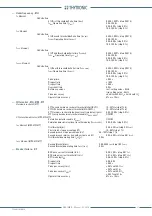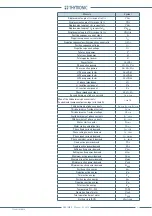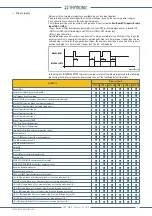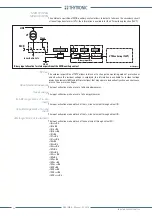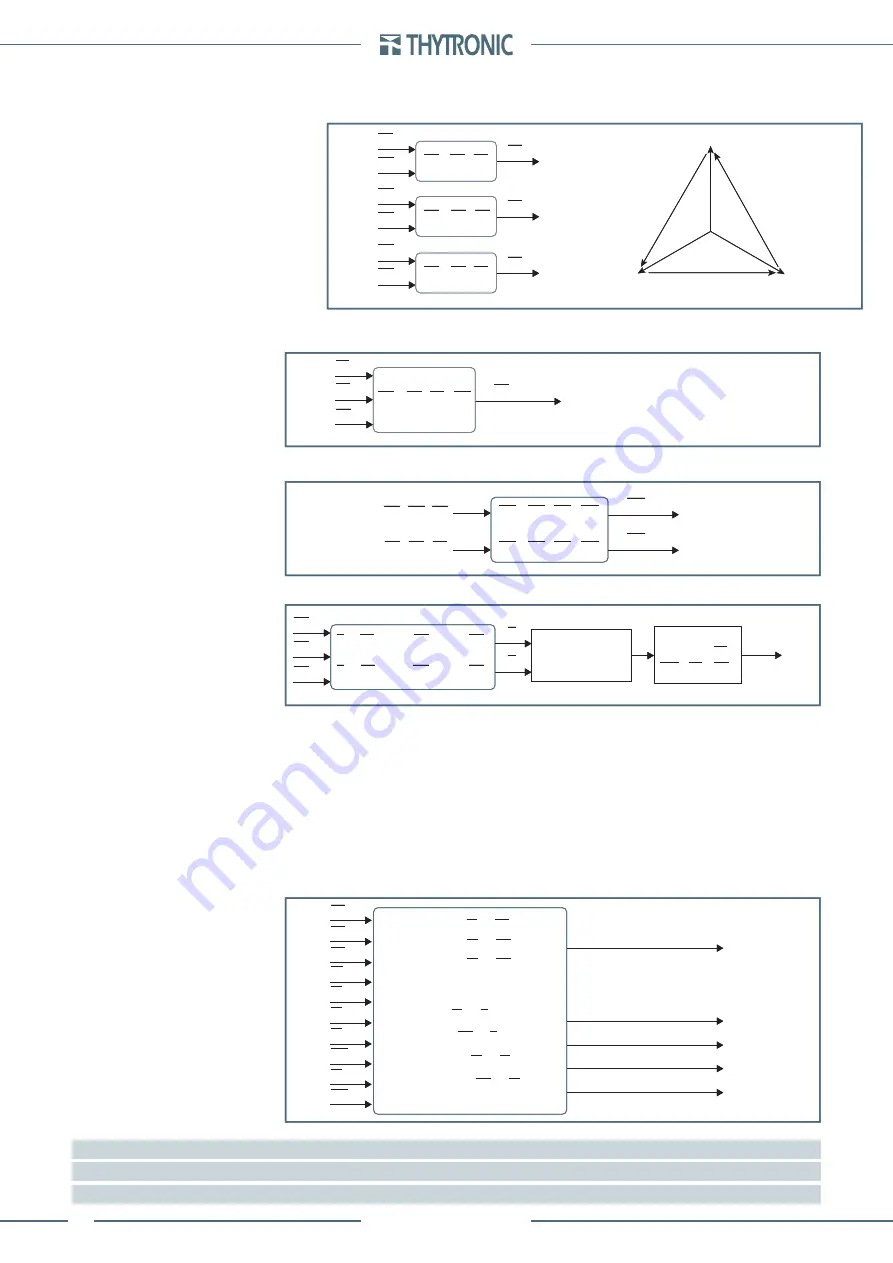
48
NVA100X-D - Manual - 02 - 2016
FUNCTION CHARACTERISTICS
By means vector addition of direct measures the following are calculated (RMS value of fundamen-
tal components):
Phase-to-phase voltages:
U
12
,
U
23
,
U
31
Fundamental component of the calculated residual voltage
U
EC
[1]
Fundamental component of the calculated residual currents
I
ECH
and
I
ECL
[2]
Thermal image Δ
θ
Phase
[3]
Displacement angle of any phase current respect the corresponding phase-to-neutral voltage:
Phi
L1
,
Phi
L2
,
Phi
L3
,
Displacement angle of the measured residual current respect the measured residual voltage (posi-
tive with current in lagging direction in respect to voltage):
Phi
E
,
Displacement angle of the measured residual current respect the calculated residual voltage (pos-
itive with current in lagging direction in respect to voltage):
Phi
EC
Displacement angle of the calculated residual current respect the measured residual voltage (pos-
itive with current in lagging direction in respect to voltage):
Phi
E_IEC
Displacement angle of the calculated residual current respect the calculated residual voltage
(positive with current in lagging direction in respect to voltage):
Phi
EC_IEC
Note 1 The residual voltage is available as a direct measure U
E
and computed measure U
EC
,
Note 2 The residual currents are available with either direct measurement (IE1 and IE2) and as calculated measure
(
I
ECH
and I
ECL
)
Note 3 The adjustment and display range of displacements are 0°... 359°
•
•
•
•
•
•
•
•
•
U 1 2 . a i
U
L1
U
12
=
U
L1
-
U
L2
U
12
U
23
U
31
U
23
=
U
L2
-
U
L3
U
31
=
U
L3
-
U
L1
U
L2
U
L2
U
L3
U
L1
U
L3
(
U
n
)
(
U
n
)
(
U
n
)
U
L1
U
12
U
31
U
23
U
L3
U
L2
U 1 2 . a i
U
L1
U
12
=
U
L1
-
U
L2
U
12
U
23
U
31
U
23
=
U
L2
-
U
L3
U
31
=
U
L3
-
U
L1
U
L2
U
L2
U
L3
U
L1
U
L3
(
U
n
)
(
U
n
)
(
U
n
)
U
L1
U
12
U
31
U
23
U
L3
U
L2
U E C . a i
U
L1
U
EC
=
U
L1
+
U
L2
+
U
L3
U
EC
U
L3
U
L2
(
U
En
)
U E C . a i
U
L1
U
EC
=
U
L1
+
U
L2
+
U
L3
U
EC
U
L3
U
L2
(
U
En
)
I E C . a i
I
ECH
=
I
L1H
+
I
L2H
+
I
L3H
I
ECH
I
ECH
=
I
L1H
+
I
L2H
+
I
L3H
(
I
nH
)
I
ECL
(
I
nL
)
I
L1H
,
I
L2H
,
I
L3H
I
L1L
,
I
L2
L
,
I
L3
L
I E C . a i
I
ECH
=
I
L1H
+
I
L2H
+
I
L3H
I
ECH
I
ECH
=
I
L1H
+
I
L2H
+
I
L3H
(
I
nH
)
I
ECL
(
I
nL
)
I
L1H
,
I
L2H
,
I
L3H
I
L1L
,
I
L2
L
,
I
L3
L
T h e t a . a i
I
L1L
I
2
I
2
= (
I
L1L
+ e
-j120°
I
L 2 L
+ e
+j120°
I
L 3 L
)
I
1
= (
I
L1L
+ e
+j120°
I
L 2 L
+ e
-j120°
I
L 3 L
)
I
L3L
I
L2L
I
1
I
t h
= √(
I
1
2
+
K
2
2
∙
I
2
2
)
Δ
θ
(Δ
θ
B
)
2
dΔ
θ
dt
I
B
I
t h
Δ
θ
T+
T+
( )
+
=
T h e t a . a i
I
L1L
I
2
I
2
= (
I
L1L
+ e
-j120°
I
L 2 L
+ e
+j120°
I
L 3 L
)
I
1
= (
I
L1L
+ e
+j120°
I
L 2 L
+ e
-j120°
I
L 3 L
)
I
L3L
I
L2L
I
1
I
t h
= √(
I
1
2
+
K
2
2
∙
I
2
2
)
Δ
θ
(Δ
θ
B
)
2
dΔ
θ
dt
I
B
I
t h
Δ
θ
T+
T+
( )
+
=
F a s e . a i
ϕ
L1
=
I
L1
-
U
L1
Phi
L1
,
Phi
L 2
,
Phi
L 3
Phi
E
Phi
EC
(
°
)
(
°
)
(
°
)
U
L1
ϕ
L 2
=
I
L 2
-
U
L 2
ϕ
L 3
=
I
L 3
-
U
L 3
ϕ
E
=
U
E
-
I
E
ϕ
EC
=
U
EC
-
I
E
Phi
E_IEC
Phi
EC_IEC
(
°
)
(
°
)
ϕ
E_IEC
=
U
E
-
I
EC
ϕ
EC_IEC
=
U
EC
-
I
EC
U
L2
U
L2
I
L1L
I
L2L
I
L3L
U
E
U
EC
I
EC
I
E
F a s e . a i
ϕ
L1
=
I
L1
-
U
L1
Phi
L1
,
Phi
L 2
,
Phi
L 3
Phi
E
Phi
EC
(
°
)
(
°
)
(
°
)
U
L1
ϕ
L 2
=
I
L 2
-
U
L 2
ϕ
L 3
=
I
L 3
-
U
L 3
ϕ
E
=
U
E
-
I
E
ϕ
EC
=
U
EC
-
I
E
Phi
E_IEC
Phi
EC_IEC
(
°
)
(
°
)
ϕ
E_IEC
=
U
E
-
I
EC
ϕ
EC_IEC
=
U
EC
-
I
EC
U
L2
U
L2
I
L1L
I
L2L
I
L3L
U
E
U
EC
I
EC
I
E




